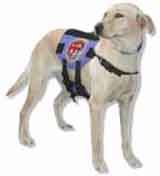Dog Behavior Problems and TrainingAggressive Dog Behavior |
|
|
Aggressive temperaments in canines are usually the result of both genetics and the environment. A dog's environment can trigger aggressive behavior, particularly if he has a propensity toward aggression. For instance, people often blame a dog's aggression on being abused or teased by children. Fortunately, a dog's environment can be modified to protect him from abuse and teasing. You can and should insulate the dog's space from negative interactions and incidents that might prompt aggression you cannot control. A chain link fence does not adequately protect the dog when the owner is at work or away because individuals or poorly supervised children may have access to him through the fence. Leaving the dog inside the house or constructing a double fence or a run far from the street fence are safer solutions. Protecting a dog from the environment is his owner's responsibility. Aggression may also be the result of an injury. An injured dog may not understand the origin of the pain. As a result, he may snap at any object, including a helpful hand, that approaches the injured site. In cases of extreme pain, the dog may even lunge at anyone walking close. No matter how gentle a dog's temperament is under normal circumstances, take precautions such as using professional handling gloves, a muzzle, or at the least, wrap cloth around your hands before touching an injured dog. Females with litters will often exhibit aggressive behavior around their puppies. Aggression associated with protecting the young is a natural behavior, and correcting the bitch may produce unnecessary negative interactions. The majority of bitches will allow trusted individuals to handle their puppies. Take time to gain the trust of the bitch before attempting to handle her puppies. Many bites are the result of an unsuspecting passerby or visitor invading the dog's perceived territory. No one should walk into another person's (dog's) yard or house uninvited, and certainly the house or yard should not be left open for people to enter. High fences can prevent children from scaling them to retrieve lost balls, and security locks on gates are good deterrents for the average person. Even the mildest mannered dog may feel threatened by people walking in or invading his territory, especially when no one is home. Then again, there may be no apparent provocation for the dog to bite. This type of attack is known as rage syndrome or idiopathic aggression, and it is very dangerous. When a dog bites for no apparent reason, the victim is least able to avoid the bite. There may be no cues to indicate an impending attack. This type of aggression has been associated with a few specific breeds, but there have been reports of unprovoked attacks in many breeds. Back to the Dog Behavior Problems and Training page
| |
|
Related News About Dogs ' ); // get rid of newsfeed display by carp CarpConf('poweredby',''); CarpCacheShow('http://dogguidance.com/dogblog/?feed=rss2'); ?>
|
|
|
|
|
|
Copyright © 2006-2007 dogguidance.com |


